5 ASE Takeaways on Energy Efficiency from COP 29
Let's Save Energy
Alliance to Save Energy's Blog

The Alliance to Save Energy (ASE) hit the ground running in Baku, Azerbaijan at the 29th Conference of the Parties (COP 29) from November 11 – 24. The Alliance was represented by AVP of Policy and Research Sapna Gheewala Dowla, Board Member Bob Hinkle of Metrus Energy, and a large delegation of ASE member companies.
Our goal at COP 29 was to do at a global level what we have been doing in the United States since our inception: championing the importance of energy efficiency as a smart, nonpartisan, practical solution to the challenge of climate change.
The Alliance’s presence at international events like COP is critical because what happens on the global stage impacts U.S. domestic policy and the energy efficiency market for American businesses. There is a lot at stake and the voice of the Alliance – and the U.S. energy efficiency industry – must be loud and clear.
With this in mind, we spent our time in Baku building new partnerships, engaging U.S. and international policymakers, sharing best practices, and participating on a broad range of panels and events where we championed the importance of energy efficiency as a cornerstone of the energy transition.
These are the Alliance’s five main takeaways from COP 29:
1. America Is All In.
The durability of the Inflation Reduction Act was a big theme at COP 29. Leaders from private businesses, states, cities, and municipalities were optimistic about the continued growth of the clean energy economy. There was consensus that regardless of administration the clean energy economy has momentum at the subnational level and that underlying economic drivers show progress. Energy efficiency and other clean energy investments are good for jobs, business, and the environment. The Alliance is proud of the work we do in support of this landmark legislation.
2. Time to Double Down on Energy Efficiency.
Many U.S. businesses are not sufficiently engaged in advocating for actionable global energy efficiency policies and programs. The Alliance is playing a leading role on the recently formed Mission Efficiency Global Ambition Taskforce and signed an open letter to the COP Presidencies Troika calling on the COP presidency, governments, and businesses to make energy efficiency a priority at COP 30. Specifically, the Alliance supports the call to double the rate of global energy efficiency improvement by 2030, to include actionable energy efficiency measures in updated Nationally Determined Contributions, and to invest more than $1.8 trillion per year in energy efficiency measures by 2030.
3. Climate Plans are Finance Plans.
Dubbed the “Finance COP,” formal COP 29 outcomes included a new collective goal for $300 billion of international climate finance by 2035—well short of the estimated $1.3 trillion needed annually. Critical to bridging the gap will be private sector investments and innovative financing solutions anchored to energy efficiency, which the International Energy Agency estimates can account for 40% of the total energy-related GHG emissions required to hit the targets of the Paris Agreement.
4. Messaging on Energy Efficiency is Evolving.
A common thread in COP events and discussions was the fact that energy efficiency projects impact a vast array of stakeholders, with outcomes reaching beyond energy savings. Businesses, utilities, and governments at all levels are recognizing the multitude of benefits energy efficiency provides — from grid reliability, building resilience and readiness, worker productivity, and health-related benefits like improved air quality or sustainable cooling. As an industry, we need to capitalize on this trend and ensure that the full benefit case for energy efficiency is being made.
5. A “Big Tent” Approach.
Lisa Jacobson of the Business Council for Sustainable Energy talked at COP about “taking a big tent approach” to accelerating climate action. COP 29 saw growing recognition that our best chance of warding off the worst effects of climate change hinges on using all the technical and financial climate solutions on hand today. Like the Alliance’s successful inclusion of energy efficiency in the EPA’s Solar for All program, there is need at the global level to link the power of renewables, electrification, sustainable cooling, and energy efficiency. We can no longer have a one-size-fits-all approach.
Energy Efficiency Events at COP 29
Several important events shaped the COP 29 energy efficiency conversation. Here’s a rundown of key moments:
UNFCCC Exhibit
In the booth: BCSE, the Corn Refiners Association, and the Environmental and Energy Study Institute. And, of course, the Alliance!
Takeaway: This exhibit showcased a portfolio of existing energy efficiency, clean energy, and circular economy solutions that deliver both mitigation and adaptation benefits, case studies of success, and opportunities for public-private partnerships.
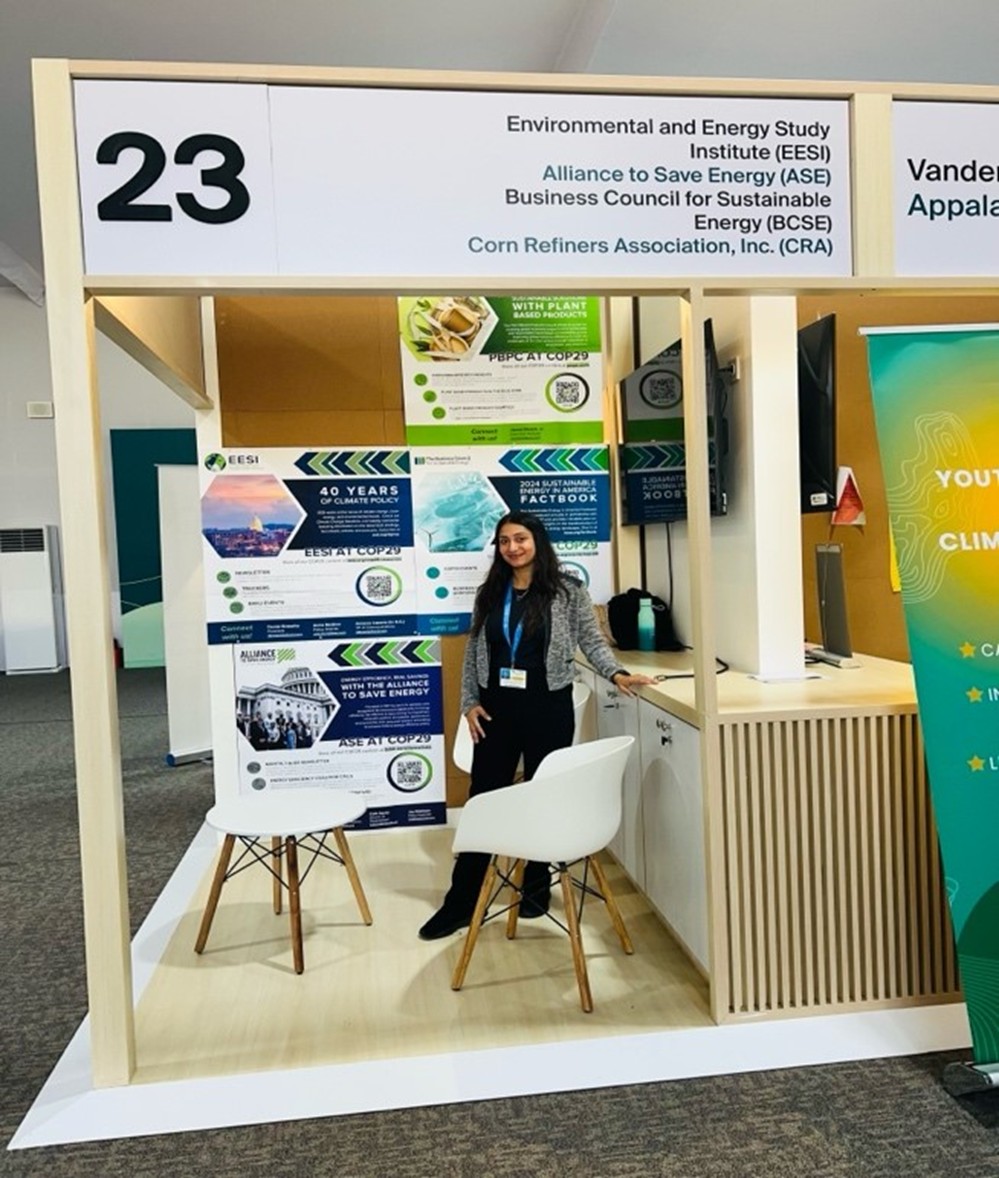
Mission Efficiency Coalition Calls for Progress on the Global Energy Efficiency Goal
Press Conference: BCSE and Mission Efficiency held a press conference on the Mission Efficiency Call. BCSE President Lisa Jacobson was joined by Kofi Agyarko, Director of Renewable Energy and Energy Efficiency for the Energy Commission of Ghana; Jon Creyts, CEO of RMI; and Bruce Douglas, CEO of the Global Renewables Alliance.
Takeaway: The world is off track in reaching the COP 28 global goal to double the global average annual rate of energy efficiency improvements by 2030. The coalition of countries, businesses, and organizations (including the Alliance) urged world leaders to commit to actionable measures to unlock energy efficiency investment. To stay aligned with collective climate goals, investment in energy efficiency must triple by 2030 and primary energy intensity needs to improve from 1% to 4%.
Read more about the call here.
Materials to Systems: Scaling Finance for Energy Efficiency, Clean Energy, and Biobased Solutions
Alliance-hosted panel: We partnered with the International Council for Sustainable Energy and the Plant Based Products Council in a side event exploring how innovative materials, financing mechanisms, and clean energy deployment can converge to deliver real-world solutions.
Takeaway: Alliance AVP of Policy and Research, Sapna Gheewala Dowla, moderated a panel of experts, leading off by sharing that achieving scale in energy efficiency requires us to integrate new materials into our supply chains, collaborate across borders, and finance transition in inclusive and equitable ways.
“The path to net zero is multifaceted, demanding an ecosystem of solutions including renewable energy, hydrogen, and advanced storage, with energy efficiency forming the foundation,” Gheewala Dowla said. “It reduces waste, lowers costs, and unlocks the full potential of other technologies. Simply put, we cannot decarbonize without it.”
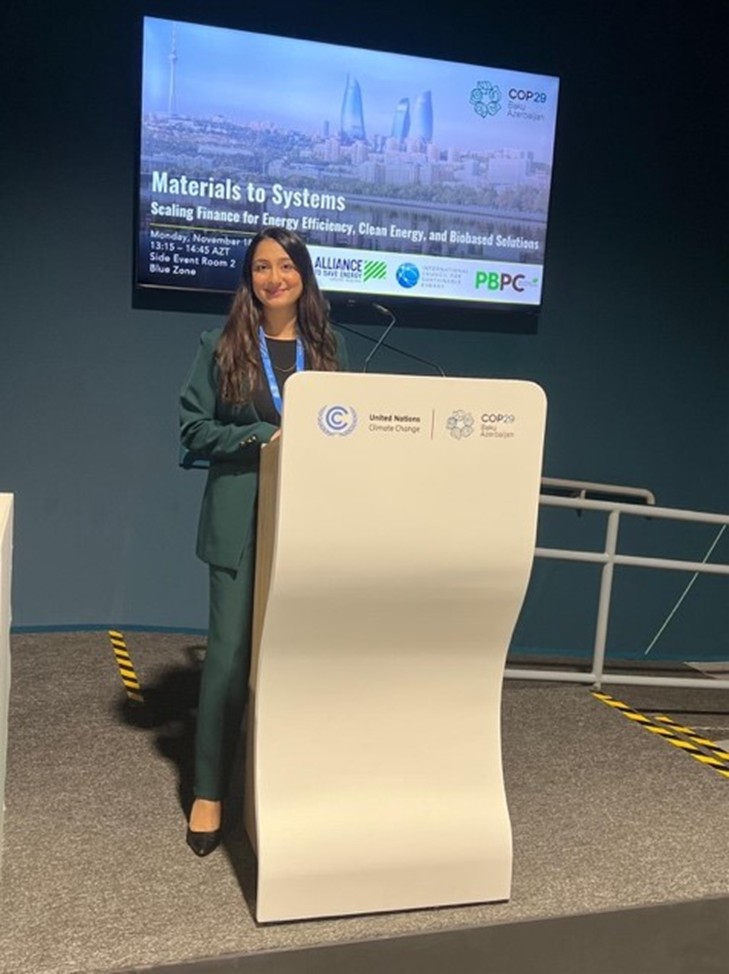
Part of the discussion took a deep dive into the deployment and finance of energy solutions. Bob Hinkle of Metrus Energy and Helen Walter-Terrinoni of Trane Technologies highlighted "energy efficiency first" as the primary solution to decarbonization, calling for investment decisions that realize the full range of benefits that energy efficiency provides.
BCSE Bilateral Discussion with U.S. Department of Defense
Speakers: Brendan Owens, Assistant Secretary of Defense for Energy, Installations, and Environment and Chief Sustainability Officer, alongside Iris Ferguson, Deputy Assistant Secretary of Defense for Arctic and Global Resilience.
Takeaway: Owens and Ferguson shared that the main driver of investment for military installations is readiness and resiliency. Investments in energy efficiency and clean energy deliver these benefits to bases, and access to clean technology continues to expand.
Advancing the Energy Transition Towards 2030: Finance, Technology, and People
Speakers: Kristen Delano, Government and PR Lead, Koloma; Rhian Kelly, Chief Sustainability Officer, National Grid; Ilmari Lastikka, Global Head, STX Commodities; Yvonne McIntyre, VP, PG&E.
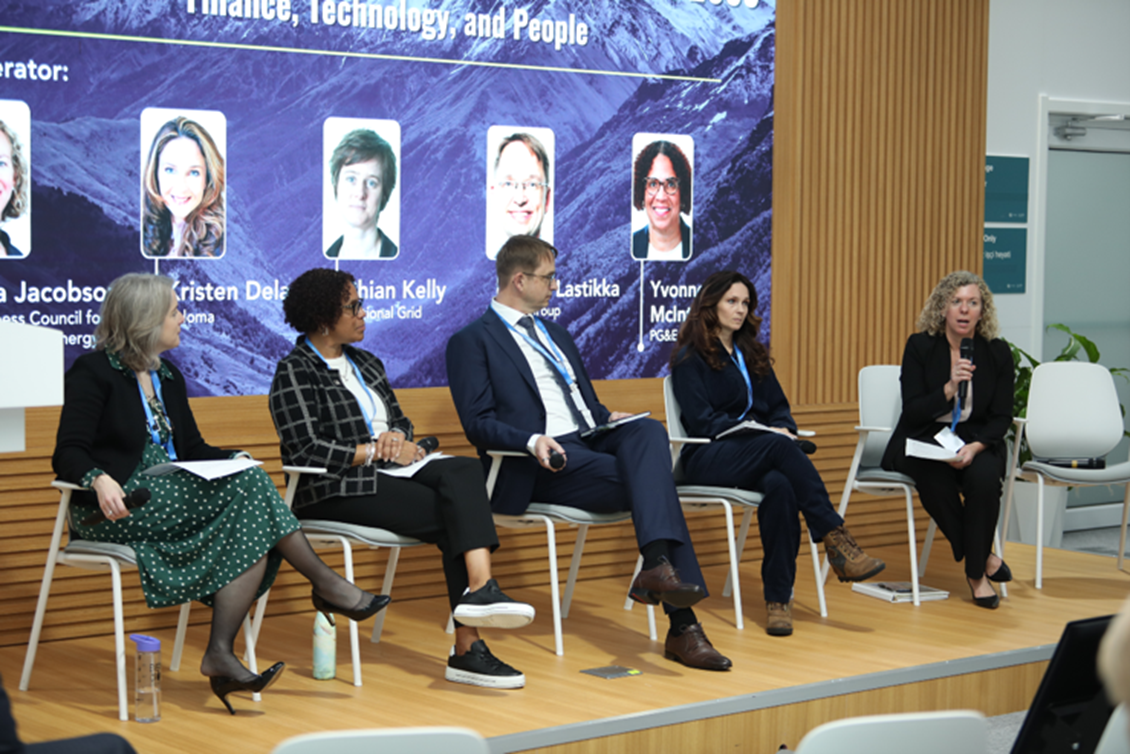
Takeaway: Energy companies must have a long-term view of energy transition finance to ensure investment security. The energy transition presents an opportunity to create jobs and strengthen workforce development. Community engagement is key.
“The customer is at the heart of everything that we do in our community,” McIntyre said. “We want everyone to benefit from the energy transition. PG&E is investing largely in electric vehicles and tackling how to meet the load growth of electrification.”
Rethinking Decision-Making in Sustainable Energy Investments
Keynote: Brendan Owens, Assistant Secretary of Defense for Energy, Installations, and Environment and Chief Sustainability Officer
Speakers: Bob Hinkle, CEO, Metrus Energy; Kevin Rabinovitch, VP, Mars; Mayor Hollies Winston, City of Brooklyn Park, MN
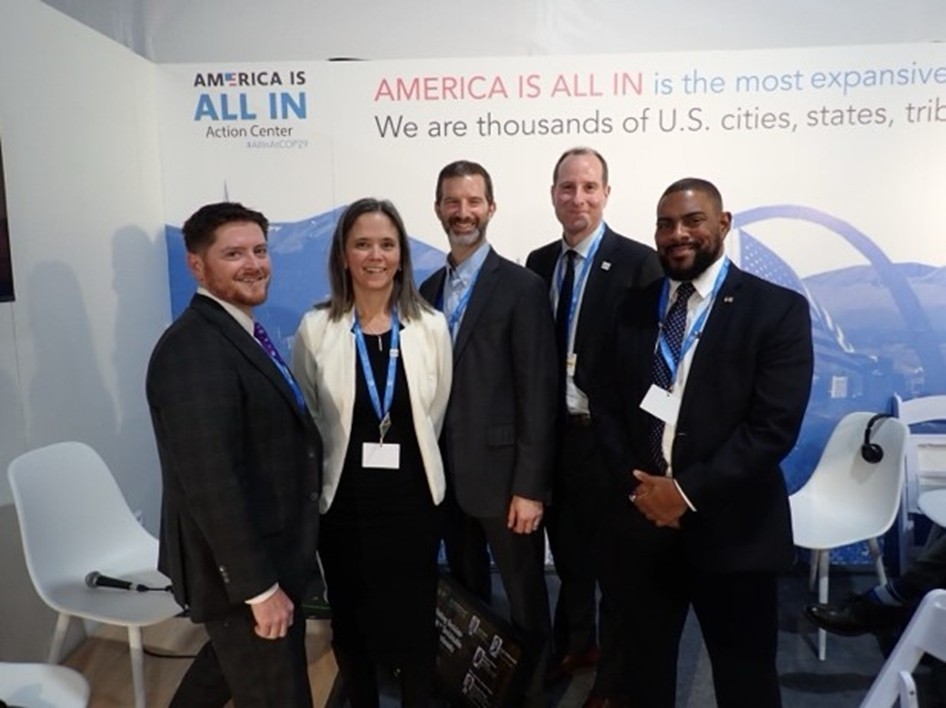
Takeaway: Regardless of the U.S. federal government’s position, energy transition work is moving forward at the subnational level. Simply put, an economy has been created from the transition and cannot be abandoned.
“The benefits of sustainable energy projects are often undervalued because the true breadth of economic, health, and productivity benefits aren’t in the criteria for making investment decisions,” Hinkle said. “50% of progress on the Paris agreement can come from energy efficiency. There is not major technology advancements needed there – they’re projects we can move on now.”
Also, at the America Is All In pavilion, Alliance member Carrier participated in a panel on the importance of codes and standards in driving building decarbonization.
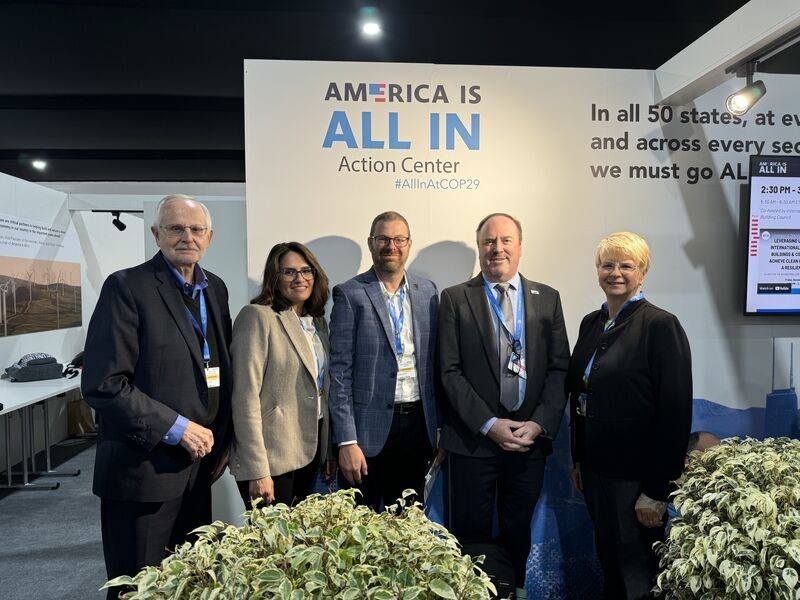
Business Leaders on Solutions to Bridge the Clean Energy Investment and Deployment Gap
Speakers: Stacy J. Ettinger, VP, SEIA; Bob Hinkle, CEO, Metrus Energy; Paul Lau, CEO, SMUD; Mike Train, Chief Sustainability Officer, Emerson
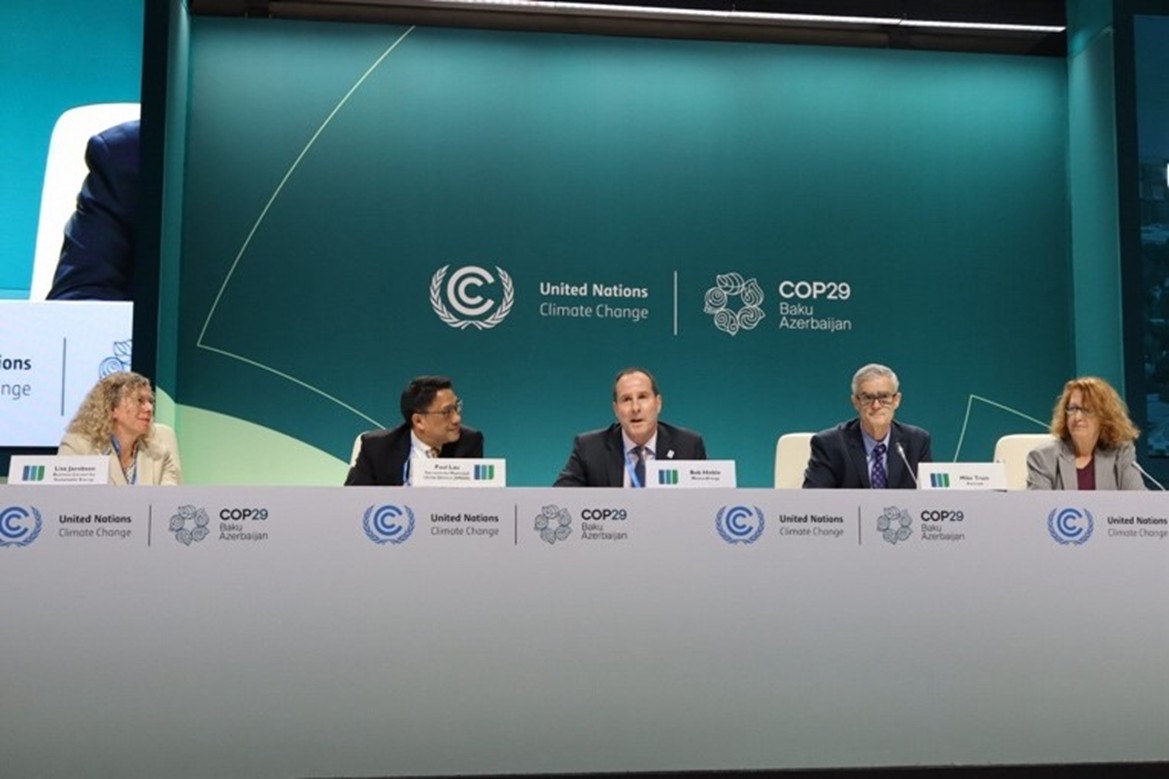
Takeaway: This BCSE-hosted press conference featured business leader insights on four areas in which private sector leadership is needed to get clean energy projects off the ground: finance, workforce development, technological innovation, and supply chain management. Public-private partnerships were seen as the key to overcoming barriers.
BCSE Hosts Annual International Dinner at COP 29
At the annual BCSE clean energy industry dinner, attendees heard remarks from energy efficiency and renewable energy leaders on partnering across industries to achieve energy transition goals – including remarks from Sapna at the Alliance.
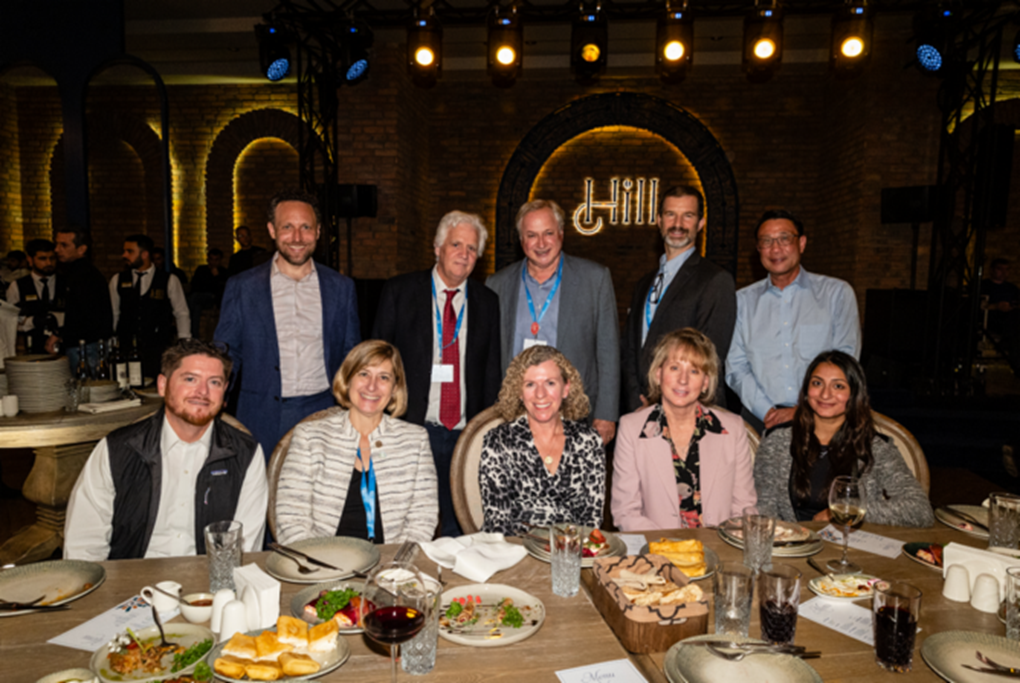
What’s Next?
What can you do to keep the COP 29 energy efficiency momentum going? Here are three ways:
- Sign onto the Mission Efficiency official letter to the COP Presidencies Troika – a collaborative effort between United Arab Emirates (host of COP 28), Azerbaijan (host of COP 29), and Brazil (host of COP 30 in 2025) – urging commitment to the global goal of doubling energy efficiency improvements annually through 2030.
- Stay connected to the Alliance as we continue to engage U.S. businesses, stakeholders, consumers, and lawmakers to amplify education about energy efficiency.
- Explore additional resources:
RECENT BLOG POSTS
STAY EMPOWERED
Help the Alliance advocate for policies to use energy more efficiently – supporting job creation, reduced emissions, and lower costs. Contact your member of Congress.
Energy efficiency is smart, nonpartisan, and practical. So are we. Our strength comes from an unparalleled group of Alliance Associates working collaboratively under the Alliance umbrella to pave the way for energy efficiency gains.
The power of efficiency is in your hands. Supporting the Alliance means supporting a vision for using energy more productively to achieve economic growth, a cleaner environment, and greater energy security, affordability, and reliability.



